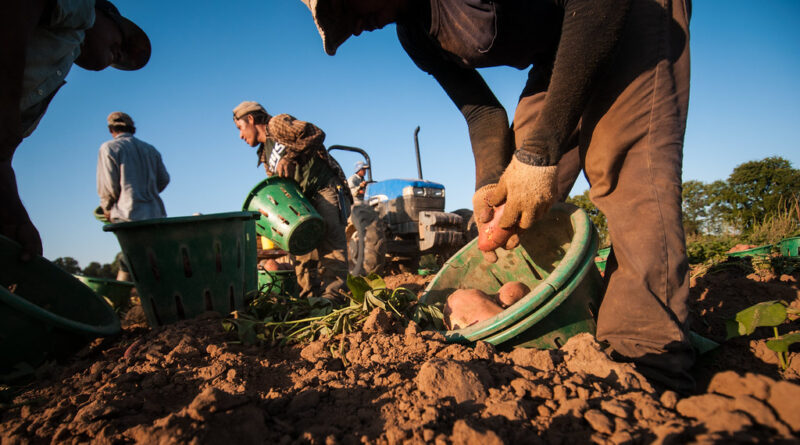COVID-19 and the Crisis of Migrant Worker Housing
By: Alexa Kort and Matthew Dunn
For migrant workers across the world, the COVID-19 pandemic has brought an interrelated set of crises. Along with the dangers of the virus itself, migrant workers─who are overrepresented in industries that require in-person work─are experiencing increased housing instability as rent payments become overwhelming and the threat of eviction looms. And for those with the stability to retain their housing, many face enhanced risk of contracting the virus due to unsafe housing conditions. To date, national COVID-19 relief efforts have utterly failed to protect migrants.
Never has it been more clear that safe living accommodations are critical to ensuring public health. It is thus urgently necessary that all countries implement decisive, enforceable national housing support policies that protect the health and safety of migrant workers by halting evictions, assisting with housing payments, and providing safe isolation spaces.
Housing conditions are a key determinant of migrant health
Even before COVID-19, migrant workers faced poor living conditions and several dimensions of housing instability including housing discrimination, difficulty paying rent, and frequent relocation. This pandemic has only exacerbated these existing vulnerabilities for migrant workers, which in turn have worrisome implications for their health.
Migrant worker housing is often overcrowded, poorly ventilated, and lacking clean water or facilities for handwashing, and these substandard conditions heighten the risk for COVID-19 transmission. Communal migrant worker housing facilities have emerged as a hotspot for outbreaks in wealthier countries like Singapore, the U.S., and several gulf states. However, these facilities often house migrants from lower-income countries such as Nepal and Syria. Further, poor housing quality can affect migrant workers’ stress and their risk of other chronic health conditions that may predispose them to morbidities due to COVID-19.
For migrant workers, a highly marginalized workforce facing precarious employment and unstable income, the risk of eviction is ever-present. Migrant workers are often not included in the social and labor protections of their host countries or may face barriers to accessing social security for which they are eligible. For example, migrant farmworkers in the U.S. are excluded outright from many labor standards including minimum wage and overtime pay – as well as social benefits such as Medicaid or unemployment. In British Columbia, Canada, migrant farmworkers are eligible for provincial health insurance starting three months after their arrival in the country, but this delay may leave them unprotected for much of their temporary employment. With few legal protections, workers who raise concerns about unsafe living and working conditions risk losing their jobs and thus their ability to pay rent. Those living in employer-provided accommodations stand to lose both their jobs and their housing. Migrant workers may face a number of barriers to protecting their housing, including fear of immigration enforcement, lack of legal resources, and unjust or inefficient mechanisms for dispute settlement.
For these reasons, we urge national governments worldwide to adopt policies that ensure housing stability for migrant workers in order to safeguard their wellbeing during and after the pandemic.
National governments can provide immediate relief by halting evictions
As a critical first step to protect housing stability for migrant workers, federal governments must enact temporary eviction moratoria. These moratoria have proven to be an effective strategy to mitigate the spread of infectious diseases like COVID-19. They enable individuals to practice social distancing, including quarantine when necessary, and they prevent homelessness and shelter overcrowding. This was demonstrated when the British government instituted a temporary moratorium on evictions and provided shelter to all unhoused individuals, which was successful in mitigating transmission of the virus.
Eviction moratoria are especially critical for migrant workers, whose housing situation is often precarious and closely tied to their employment. Housing is a fundamental human right, and landlords and employers cannot be allowed to force migrant workers out of their housing.
Direct payment assistance is a needed complement to eviction protections
Importantly, eviction freezes must be implemented in tandem with other protections. The problem with legal protections alone is that administrative and enforcement inconsistencies will still leave some vulnerable. For example, the U.S. COVID-19 relief package (CARES Act) included a temporary ban on evictions, but lacked details of how this would be enforced. Thus, it was unsurprising that a July 2020 national survey by the National Housing Law Project found that 91 of 100 legal aid attorneys reported an illegal eviction in their area.
Further, once the moratorium expires, renters will still be responsible for accumulated debt from missed rent payments, plus the burden of additional rent going forward. We need solutions that will offer long-term security, rather than deferring the problem to later down the line.
Therefore, providing rent and mortgage payment assistance is necessary to ensure vulnerable migrant workers retain their housing. A comprehensive review of housing policy in the U.S. during the Great Recession found that direct financial payments were among the most effective means of preventing housing-insecure people from falling into homelessness. In the midst of another global economic crisis, maintaining housing security among this population will require governments to provide financial relief to cover housing costs.
Such assistance can be delivered through multiple payment models. In the U.S, one option is to expand investment in the existing federal housing choice voucher program, supported by the Department of Housing and Urban Development (HUD). Through this program, HUD allocates funds to local public housing agencies, which in turn administer vouchers paid directly to landlords on behalf of eligible participants. It is also possible to establish new programs for targeted relief during periods of economic downturn. For example, in 2008 Congress authorized the $1.5 billion Homelessness Prevention and Rapid Re-housing Program (HPRP). Administered through HUD over 3 years, this program provided state and local governments grants to deliver payment assistance to families facing homelessness and housing instability. When HPRP concluded in September 2012, 89.9 percent of participants entered permanent housing.
Migrant workers often live in overcrowded conditions – dangerous during a pandemic and overdue for reform
Finally, once housing accommodations are secured, it is important to ensure these facilities are safe. Physical distancing is an important measure to contain the spread of COVID-19, but is impossible for migrant workers living in cramped trailers, barracks, and dormitory-style housing. Swift intervention is needed to address overcrowding and poor sanitation.
The government of Singapore’s prompt response to COVID-19 outbreaks in foreign worker dormitories offers an example of important first steps for an intervention. To enable compliance with physical distancing guidelines, the government rapidly created new housing accommodations for migrant workers by repurposing existing facilities such as hotels, military camps, and community centers. Singapore also designated specific dormitories for quarantine, so healthy and infected workers could be housed separately.
As the COVID-19 pandemic has acutely demonstrated, housing policy must be a priority when designing public health policy. While steps to improve substandard housing conditions among migrant workers are long overdue, this pandemic has only added to the urgency for reform. Overcrowding is a worldwide problem, and thus ensuring that the most vulnerable are protected from housing instability must be a public health priority, especially for groups often overlooked in policymaking. In this time of extreme economic hardship, urgent action is necessary to ensure that migrant workers have access to housing that is both secure from eviction and compliant with COVID-19 safety protocols.
Photo of farm workers in Virginia by the US Department of Agriculture available on flicker.com
Matthew Dunn is a graduate student researcher at the University of Michigan School of Public health in the department of Health Management and Policy. He is interested in epidemiological and social research, with the purpose of informing public policy to improve population health.
Alexa Kort is a graduate student researcher at the University of Michigan School of Public Health in the Department of Epidemiology. She is interested in community-engaged epidemiological research that investigates how social injustice, inequality, and policy shape health disparities.







